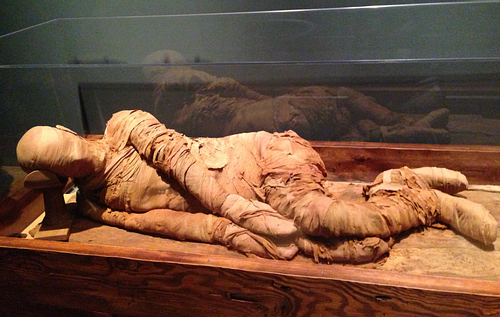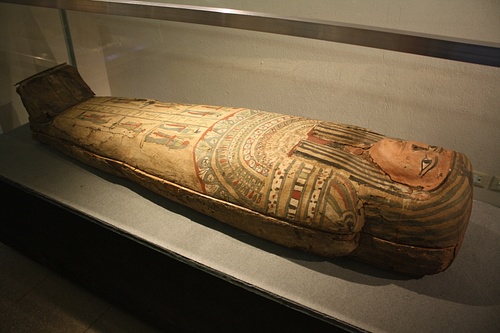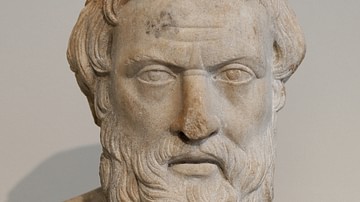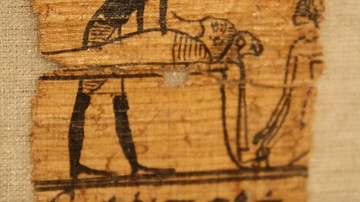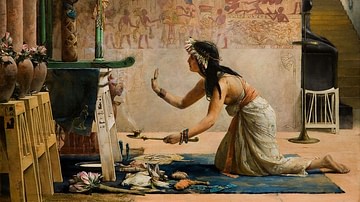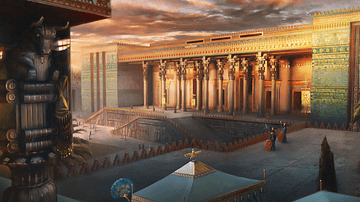Herodotus' section of his Histories on burial in ancient Egypt (Book II.85-90) is an accurate description of Egyptian mummification, but he purposefully omits the spiritual significance of embalming in keeping with his commitment to refrain from discussing the religious beliefs of other cultures. The spiritual aspect of embalming, however, was central to the practice and is addressed indirectly.
This is not to say that Herodotus' account is wrong, only that it may seem incomplete as he clearly explains how embalming was practiced during the Late Period of Ancient Egypt (525-323 BCE), but not the reason for it. Embalming was intimately associated with Egyptian religion, which Herodotus seems to avoid addressing for his own reasons. Herodotus (l. c. 484-425/413 BCE) makes his policy on religious discussions clear, however, earlier in Book II when he deals with the sacred aspect of animals in Egypt:
All the animals in Egypt are regarded as sacred. Some are domesticated, and others are not, but if I were to explain why some animals are allowed to roam free, as sacred creatures, my account would be bound to discuss issues pertaining to the gods, and I am doing my best to avoid relating such things. It is only when I have had no choice that I have touched on them already.
(II.65)
Herodotus actually addresses religious issues frequently throughout his Histories as in the case of Croesus (I.47-91), Cyrus (I.124-126), Persian religious customs (I.131), Themistocles' speech to the Athenians (VIII.109), earlier in his discussion of the Egyptians (II.36-37) and elsewhere. When he claims to be avoiding religious issues, then, what he means is he will discuss practices and events relating to the gods but will not comment on their spiritual significance, though he sometimes slips and does this as well.
It is possible, as some have claimed, that he simply did not understand the religious significance of embalming to the Egyptians, but it is far more likely that he omits commentary for any number of reasons including the personal nature of religious belief and how a discussion of Egyptian beliefs might affect how his audience received the culture. His passage on Egyptian burial is in keeping with his tendency to emphasize positive aspects of a culture he wants his Greek audience to either admire (Egyptians) or understand better (Persians) in the same way he advances a negative narrative concerning those he does not seem to care for (Lydians).
In his section on burial in Egypt, then, he stays close to the actual practice in the interests of informing his readers on funerary rites but omits the deeper meaning as it might have offended the Greeks' own understanding of death, burial, and the afterlife. A reflection on the structure of the chapters in his burial passage, however, suggests he knew the spiritual significance of his topic and did address it, only obliquely.
Spiritual Significance of Mummification
The Egyptian understanding of the soul was far more complex than the Greek. The Egyptians understood the soul as being comprised of nine aspects:
- Khat was the physical body.
- Ka was one's double-form.
- Ba was a human-headed bird aspect, which could speed between the earth and the heavens.
- Shuyet was the shadow self.
- Akh was the immortal, transformed self.
- Sahu and Sechem were aspects of the Akh.
- Ab was the heart, the source of good and evil.
- Ren was one's secret name.
After death, the ka and ba needed to be able to recognize the khat in order to travel from the other realm to the tomb to receive the prayer offerings and sustenance that enabled their continued existence, and comfort, in the afterlife. The deceased needed to be remembered by the living in order for their akh to remain vibrant in the paradise of the Field of Reeds and the deceased needed to be shown proper respect upon their departure from earth for the same reason. Mummification and an elaborate sarcophagus in the image of the deceased were thought to provide for the soul in this.
The practice of mummification also served as a cleansing ritual, purifying the body of the sins of life in preparation for the soul's journey to the Hall of Truth to stand in judgment before Osiris, Lord of the Dead, and the Forty-Two Judges. Scholar Jan Assmann explains:
Guilt, accusation, enmity, and so forth are treated as forms of impurity and decay – as, so to say, immaterial but harmful substances – that must be eliminated so as to transpose the deceased into a condition of purity that can withstand decay and dissolution. Vindication was moral mummification. When the embalmer's work on the corpse was done, the priests took over and extended the work of purification and preservation to the entirety of the person. The Egyptian word for 'mummy' also meant 'worthy' and 'aristocrat'. In this last stage of the mummification process, the deceased experiences the Judgment of the Dead and received the aristocratic status of a follower of Osiris in the Netherworld.
(Chapman, 81)
If the body of the deceased was not treated with the proper care, the soul might return to earth to haunt the living, causing all kinds of problems, until that wrong was righted. Scholar Sarah Lynn Chapman notes how the judgment of the soul in the afterlife was believed to begin during the embalming process when the sins of the righteous were removed with the organs that would have been tainted by those sins, thereby making the soul's spiritual heart lighter and prepared for judgment; for the unrighteous, however, the embalming process would have been a torture as they were thought to cling to their sins and so the removal was a painful experience.
The Text
In the following passages, Herodotus seems to limit himself to describing what he observed (or was told) regarding mourning and burial without explicitly touching on the higher significance. In II.86, when he discusses the optimal (and most expensive) method of mummification, he notes:
[The embalmers] show to those who brought [the deceased] wooden models of corpses made like reality by painting, and the best of the ways of embalming they say is that of him whose name I think it impiety to mention when speaking of a matter of such a kind.
The "him" in the sentence refers to Osiris who was king of the gods until he was betrayed, murdered, and dismembered by his brother Set. The various parts of Osiris were then gathered, and he was restored to life by his sister-wife Isis and her sister Nephthys, but because he was incomplete (his penis having been eaten by a fish), he descended to the underworld, where he became Lord of the Dead. Herodotus' reluctance to name the god is in keeping with his previously stated policy regarding religion but could also have to do with speaking the name of the god of the afterlife, who was both respected and feared by the Egyptians, in a non-religious context.
He follows this same model in II.90 when writing of those who are killed by crocodiles or drown in the Nile River. He mentions how these corpses, whether Egyptians or foreigners and no matter their social class, must be embalmed "in the fairest way" (meaning the most expensive), buried in a sacred place, and only the priests can handle the body, but he never explains why. This practice was observed because the crocodile was associated with the god Sobek, as was the Nile.

Sobek was associated with the Osiris myth as the god who (in some versions) helped Isis and Nephthys heal the god and restore him after death and so was seen as a protective deity. He was especially honored as the god who protected people from the crocodiles of the Nile and the currents and unseen dangers of the river itself. If someone were killed by a crocodile or drowned, it was thought they had been claimed by Sobek for his own reasons, and so their corpse would need to be treated reverently.
The following passages are from The History of Herodotus translated by G. C. Macaulay:
II:85. Their fashions of mourning and of burial are these: Whenever any household has lost a man who is of any regard amongst them, the whole number of women of that house forthwith plaster over their heads or even their faces with mud. Then leaving the corpse within the house they go themselves to and fro about the city and beat themselves, with their garments bound up by a girdle and their breasts exposed, and with them go all the women who are related to the dead man, and on the other side the men beat themselves, they too having their garments bound up by a girdle; and when they have done this, they then convey the body to the embalming.
II:86. In this occupation certain persons employ themselves regularly and inherit this as a craft. These, whenever a corpse is conveyed to them, show to those who brought it wooden models of corpses made like reality by painting, and the best of the ways of embalming they say is that of him whose name I think it impiety to mention when speaking of a matter of such a kind; the second which they show is less good than this and also less expensive; and the third is the least expensive of all. Having told them about this, they inquire of them in which way they desire the corpse of their friend to be prepared. Then they after they have agreed for a certain price depart out of the way, and the others being left behind in the buildings embalm according to the best of these ways thus: First with a crooked iron tool they draw out the brain through the nostrils, extracting it partly thus and partly by pouring in drugs; and after this with a sharp stone of Ethiopia they make a cut along the side and take out the whole contents of the belly, and when they have cleared out the cavity and cleansed it with palm-wine they cleanse it again with spices pounded up: then they fill the belly with pure myrrh pounded up and with cassia and other spices except frankincense, and sew it together again. Having so done they keep it for embalming covered up in natron for seventy days, but for a longer time than this it is not permitted to embalm it; and when the seventy days are past, they wash the corpse and roll its whole body up in fine linen cut into bands, smearing these beneath with gum, which the Egyptians use generally instead of glue. Then the kinsfolk receive it from them and have a wooden figure made in the shape of a man, and when they have had this made they enclose the corpse, and having shut it up within, they store it then in a sepulchral chamber, setting it to stand upright against the wall.
II:87. Thus they deal with the corpses which are prepared in the most costly way; but for those who desire the middle way and wish to avoid great cost they prepare the corpse as follows: having filled their syringes with the oil which is got from cedar-wood, with this they forthwith fill the belly of the corpse, and this they do without having either cut it open or taken out the bowels, but they inject the oil by the breech, and having stopped the drench from returning back they keep it then the appointed number of days for embalming, and on the last of the days they let the cedar oil come out from the belly, which they before put in; and it has such power that it brings out with it the bowels and interior organs of the body dissolved; and the natron dissolves the flesh, so that there is left of the corpse only the skin and the bones. When they have done this they give back the corpse at once in that condition without working upon it any more.
II:88. The third kind of embalming, by which are prepared the bodies of those who have less means, is as follows: they cleanse out the belly with a purge and then keep the body for embalming during the seventy days, and at once after that they give it back to the bringers to carry away.
II:89. The wives of men of rank when they die are not given at once to be embalmed, nor such women as are very beautiful or of greater regard than others, but on the third or fourth day after their death (and not before) they are delivered to the embalmers. They do so about this matter in order that the embalmers may not abuse their women, for they say that one of them was taken once doing so to the corpse of a woman lately dead, and his fellow-craftsman gave information.II:90. Whenever anyone, either of the Egyptians themselves or of strangers, is found to have been carried off by a crocodile or brought to his death by the river itself, the people of any city by which he may have been cast up on land must embalm him and lay him out in the fairest way they can and bury him in a sacred burial-place, nor may any of his relations or friends besides touch him, but the priests of the Nile themselves handle the corpse and bury it as that of one who was something more than man.
Conclusion
The structure of Herodotus' passage on burial in ancient Egypt, although the words skirt the spiritual significance of embalming, actually does address that subject. He begins with II.85 on mourning, which was an essential aspect of the funerary rites. Every Egyptian, no matter their social status, was given a proper burial, and public mourning was encouraged to show respect for the dead. Professional female mourners known as the Kites of Nephthys would follow behind a funeral procession lamenting the loss of the deceased as an expression of their significance while they lived and a gesture of remembrance.
Chapters II.86-88 discuss the three types of mummification, having to do with the preservation of the body of the deceased which, as noted, was done so the soul could prosper in the afterlife, a sign of respect for the once-living who were now thought to have simply moved from the realm of time to eternity. Chapter II.89 touches on the tradition regarding the corpses of women and how they were kept safe, another indication of respect for the dead and remembrance of who they had been when they inhabited the body, Chapter II:90 concludes the passage with the discussion of those taken by Sobek and honored as if they were themselves gods.
Although he claims he does not want to address religious issues, his structure touches on a central Egyptian religious belief in the continuation of life after bodily death and respect for all living things. This same paradigm can be seen in his other passages on the Egyptians, and elsewhere, suggesting Herodotus was fully aware of the religious beliefs of other cultures but chose to suggest them rather than try to explain a subject which was, and still is, considered deeply personal.


